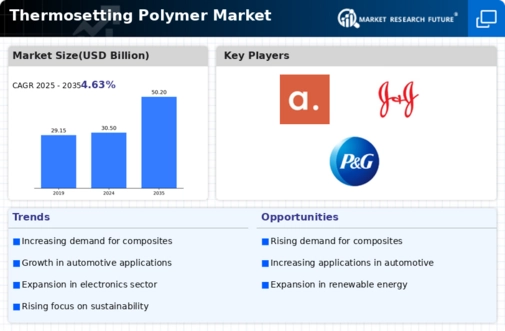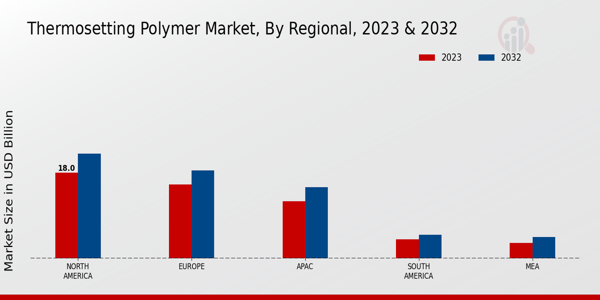Diverse Application Range
The Global Thermosetting Polymer Market Industry benefits from the diverse application range of thermosetting polymers across various sectors. These materials find utility in automotive, aerospace, electronics, and consumer goods, owing to their excellent thermal and chemical resistance. The versatility of thermosetting polymers allows manufacturers to tailor properties to meet specific requirements, enhancing their attractiveness in different industries. As new applications emerge, the market is poised for expansion, driven by the increasing adoption of thermosetting polymers in innovative products. This broad applicability suggests a sustained demand trajectory, supporting the industry's growth in the coming years.
Market Growth Projections
The Global Thermosetting Polymer Market Industry is projected to experience substantial growth, with estimates indicating a market value of 30.5 USD Billion in 2024 and a potential increase to 50.2 USD Billion by 2035. This growth trajectory suggests a compound annual growth rate (CAGR) of 4.63% from 2025 to 2035, reflecting the increasing adoption of thermosetting polymers across various industries. The market's expansion is likely driven by factors such as rising demand in automotive and construction sectors, technological advancements, and a growing emphasis on sustainability. These projections highlight the promising future of the thermosetting polymer market.
Technological Advancements
Technological advancements play a pivotal role in shaping the Global Thermosetting Polymer Market Industry. Innovations in processing techniques, such as advanced molding and curing methods, enhance the performance characteristics of thermosetting polymers. These advancements facilitate the production of high-performance composites that cater to diverse applications, including aerospace and electronics. As manufacturers adopt cutting-edge technologies, the efficiency and cost-effectiveness of thermosetting polymers improve, potentially driving market growth. The anticipated compound annual growth rate (CAGR) of 4.63% from 2025 to 2035 underscores the impact of these technological developments on the industry's future.
Growing Construction Activities
The Global Thermosetting Polymer Market Industry is significantly influenced by the growing construction activities worldwide. Thermosetting polymers are increasingly employed in construction applications, including adhesives, coatings, and insulation materials, owing to their durability and resistance to environmental factors. The construction sector's expansion, particularly in emerging economies, fuels the demand for these materials. As urbanization accelerates, the need for sustainable and resilient building materials becomes paramount. This trend is expected to contribute to the market's growth, with projections indicating a rise to 50.2 USD Billion by 2035, reflecting the increasing integration of thermosetting polymers in modern construction practices.
Rising Demand in Automotive Sector
The Global Thermosetting Polymer Market Industry experiences a notable surge in demand driven by the automotive sector. Thermosetting polymers are increasingly utilized in manufacturing components such as dashboards, bumpers, and electrical housings due to their superior thermal stability and mechanical properties. This trend aligns with the industry's shift towards lightweight materials that enhance fuel efficiency. In 2024, the market is projected to reach 30.5 USD Billion, reflecting the automotive industry's growing reliance on these materials. As electric vehicles gain traction, the demand for thermosetting polymers is likely to expand further, indicating a robust growth trajectory in the coming years.
Environmental Regulations and Sustainability
The Global Thermosetting Polymer Market Industry is also shaped by stringent environmental regulations and a growing emphasis on sustainability. Governments worldwide are implementing policies that encourage the use of eco-friendly materials, prompting manufacturers to explore bio-based thermosetting polymers. These materials not only comply with regulatory standards but also appeal to environmentally conscious consumers. The shift towards sustainable practices is likely to drive innovation within the industry, as companies seek to develop greener alternatives. This trend may enhance the market's appeal and contribute to its growth, as stakeholders increasingly prioritize sustainability in their operations.














